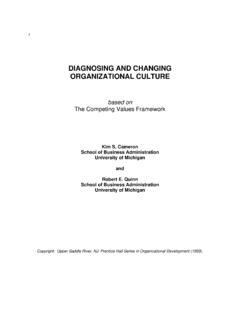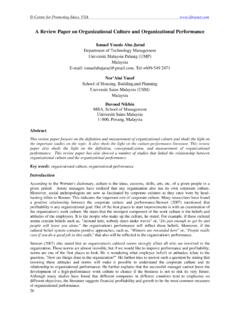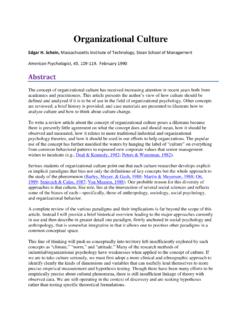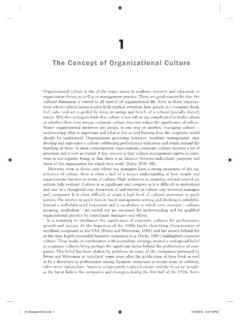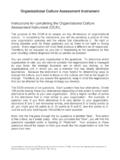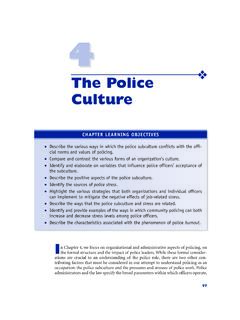Transcription of Assessment and Plan for Organizational Culture Change at …
1 Submitted to:March 15, 2004 Assessmentand plan forOrganizationalCulture ChangeatNASAA ssessmentand plan forOrganizationalCulture ChangeatNASAA ssessment and plan forOrganizational Culture Change at NASAPage 2 Executive Page55555 Assessment of the Current Page66666 Recommended Page3131313131 Appendix A: Guiding Principlesfor a Culture of Safety PageA1A1A1A1A1 Appendix B: BST SafetyClimate and Culture PageB1B1B1B1B1 Appendix C: Response Bias PageC1C1C1C1C1 Appendix D:Center-by-Center Survey PageD1D1D1D1D1 Assessment and plan forOrganizational Culture Change at NASAPage 3 Executive SummaryOn February 1, 2003, the Space Shuttle Columbia and its crew of seven were lost during return toEarth.
2 A group of distinguished experts was appointed to comprise the Columbia AccidentInvestigation Board (CAIB), and this group spent six months conducting a thorough investigationof the causes of the accident. The CAIB found that NASA s history and Culture contributed asmuch to the Columbia accident as any technical a result of the CAIB and related activities, NASA established the objective of completelytransforming its Organizational and safety Culture . BST was selected to assist NASA in the develop-ment and implementation of a plan for changing the safety climate and Culture Agency-wide.
3 Thescope of this effort is to develop and deploy an Organizational Culture Change initiative withinNASA, with an emphasis on safety climate and first task assigned to BST was to conduct an Assessment of the current status and develop animplementation plan , both to be completed within 30 days. This report summarizes the assessmentfindings and the recommended implementation Assessment concluded that there are many positive aspects to the NASA Culture . The NASA Culture reflects a long legacy of technical excellence, a spirit of teamwork and pride, and a can-doapproach to task achievement.
4 In particular, Culture attributes related to work group functioning atthe peer level are among the strongest we have seen. These characteristics are consistent withNASA s rating in the 2003 Office of Personnel Management Survey at the top of the Best Places toWork in the Federal these positive attributes, there are some important needs for improvement. The presentNASA Culture does not yet fully reflect the Agency s espoused core values of Safety, People, Excel-lence, and Integrity. The Culture reflects an organization in transition, with many ongoing initia-tives and lack of a clear sense at working levels of how it all fits together.
5 Manifesting NASA s espoused core values in the Culture : Safety is something to which NASA personnel are strongly committed in concept, but NASAhas not yet created a Culture that is fully supportive of safety. Open communication is not yetthe norm, and people do not feel fully comfortable raising safety concerns to management. People do not feel respected or appreciated by the organization. As a result the strongcommitment people feel to their technical work does not transfer to a strong commitment tothe organization. Excellence is a treasured value when it comes to technical work, but is not seen by manyNASA personnel as an imperative for other aspects of the organization s functioning (such asmanagement skills, supporting administrative functions, and creating an environment thatencourages excellence in communications.)
6 Assessment and plan forOrganizational Culture Change at NASAPage 4 Integrity is generally understood and manifested in people s work. However, there appear to bepockets where the management chain has (possibly unintentionally) sent signals that the raisingof issues is not welcome. This is inconsistent with an organization that truly values is an opportunity and need to become an organization whose espoused values are fullyintegrated into its Culture - an organization that lives the values by fostering cultural integrity. Werecommend an initiative with that as its recommended initiative should address working through existing leaders to instill behaviorsconsistent with the Agency s values and the desired Culture , while also establishing the foundationfor developing future leaders who will sustain that Culture and individual contributors who reflectthe desired Culture in their actions.
7 A long-term (three year) plan is identified with a specific seriesof actions identified for the first five months to launch this and plan forOrganizational Culture Change at NASAPage 5 IntroductionOn February 1, 2003, the Space Shuttle Columbia and its crew of seven were lost during return toEarth. A group of distinguished experts was appointed to comprise the Columbia AccidentInvestigation Board (CAIB), and this group spent six months conducting a thorough investigationof the causes of the CAIB issued its report in August 2003 with findings focused on three key areas: (1) systemicsafety cultural and Organizational issues, including decision making, risk management, and com-munication; (2) requirements for returning safely to flight; and (3) technical excellence.
8 The CAIB found that NASA s Culture and related history contributed as much to the Columbia accident asany technical a result of the CAIB and related activities, NASA established the objective of completelytransforming its Organizational and safety Culture . At a minimum, NASA targeted making measur-able progress in changing its Culture within six months; being able to demonstrate significanttransformation in its Culture within a year; and having broad changes in effect across the Agencyover a period not to exceed three years. The six-month marker was identified as particularly criticalas the Agency prepares to Return to was selected to assist NASA in the development and implementation of a plan for changingthe safety climate and Culture agency wide.
9 The scope of this effort is to develop and deploy anorganizational Culture Change initiative within NASA, with an emphasis on safety climate andculture. BST was asked to provide for a systematic, integrated, NASA-wide approach to under-standing the prior and current safety climate and Culture norms, and to diagnose aspects of climateand Culture that do not support the Agency s effective adoption of changes identified by the was further asked to propose a course or courses of action that will Change behaviors andintroduce new norms that will (1) eliminate barriers to a safety Culture and mindset.
10 (2) facilitatecollaboration, integration and alignment of the NASA workforce in support of a strong safety andmission success Culture ; and (3) align with, but not duplicate, current initiatives already underwayin the Agency such as One NASA and Return to first task assigned to BST was to conduct an Assessment of the current status and develop animplementation plan , both to be completed within 30 days. This report summarizes the assessmentfindings and the recommended implementation and plan forOrganizational Culture Change at NASAPage 6 Assessment of the Current IntroductionBST s first efforts were to understand the current Culture and climate at NASA in order to identifyfocus areas for improvement.










